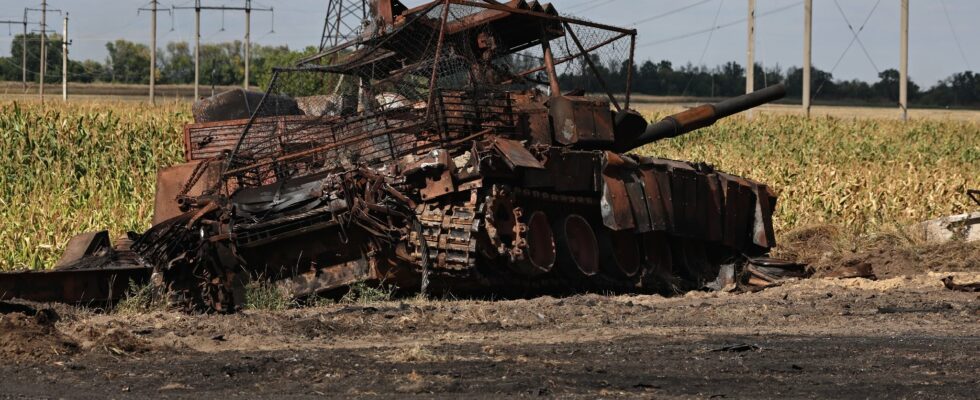In 1943, the Battle of Kursk saw the largest tank battle in history, pitting German troops against the Red Army. A little over 80 years later, in the torpor of summer, it was in this same region that Ukrainian forces launched an assault on August 6, marking the first incursion of a foreign army onto Russian soil since the Second World War. An unprecedented snub for Vladimir Putin and one of the most audacious maneuvers by the Ukrainian army, which quickly captured a hundred localities and took control of 1,200 km² of territory. More than a month after the start of this spectacular action, a new challenge now arises for kyiv’s forces: to hold their gains over time, in the face of the Russian counter-offensive launched in the region in mid-September.
In addition to the 11,000 or so Russian soldiers initially present on site to ensure the defense – including many border guards and conscripts – there have recently been around 40,000 more men, Volodymyr Zelensky indicated on September 19. Opposing them, during its assault in early August, Ukraine had aligned a force of 10,000 to 15,000 soldiers, including some of its most experienced units, before gradually strengthening its presence in the area. “Today, there are between 20,000 and 30,000 Ukrainian soldiers mobilized in this sector of the front,” notes Thibault Fouillet, scientific director of the Institute for Strategy and Defense Studies (IESD) at Lyon III University. The delay taken by Moscow to deploy fresh troops has allowed them to consolidate their gains. At this stage, the Ukrainian army still controls an advance into enemy territory of about 20 kilometers deep and about forty wide, comprising dozens of localities, including the small town of Soudja (about 5,000 inhabitants).
Attacks on the flanks
A week after the start of their counterattack, Russian forces have nevertheless claimed the capture of several villages, particularly on the western flank of the area controlled by kyiv. “The objective of the Russian command is to cut the Ukrainian forces in two, using a shearing movement, to try to encircle the troops on the front line,” said Pavlo Lakiichuk, director of security studies at the Ukrainian institute Center for Global Studies Strategy XXI. “Given the lack of Russian soldiers on the ground, however, this does not yet seem to be the start of a large-scale counteroffensive.” According to Ukrainian media outlet RBC-Ukraine, Russian authorities have ordered their troops to drive the Ukrainians out of their territory by mid-October.
The timetable seems more than optimistic. “Mounting a maneuver like this takes a lot of time to plan the movement of thousands of soldiers forward, accumulate the necessary logistics, and build up reserves of men, lists General Nicolas Richoux, former commander of the 7th Armored Brigade. It seems totally unrealistic in just a few weeks.” For the moment, the Russian contingent present in the sector still seems very thin to attempt an action of this magnitude. “An offensive generally requires a minimum of three attackers for one defender, recalls Thibault Fouillet of the ESDI. They could, however, use this slightly favorable balance of power to gradually nibble away at the Ukrainian positions, even if it will take more time.” Ukrainian human losses – relatively low at the start of their offensive – could in any case increase as Russia deploys its troops in the region.
The risk of temporary success
Aware of the risks, Ukrainian forces have already begun to fortify their positions. They had, from the first weeks of the offensive, started to dig trenches, indicating a desire to hold their gains over time. At the same time, a series of strikes were also conducted on several bridges on the Seym River, which divides the west of the region, to disrupt Russian logistics and Moscow’s efforts to build a coherent defense in the sector. In an interview with AFP on September 18, the spokesman for the Ukrainian regional command, Oleksiy Dmytrachkivsky, affirmed that the counter-offensive launched by Russian troops in the region had been “stopped” and that the situation in the area had, for the moment, been “stabilized”.
For the Ukrainians, in difficulty on the Donbass front, and whose main objective was to force Russia to draw on its troops present in the Donetsk region to redeploy them to Kursk, the ability to hold Russian territory will depend above all on the efforts made by Moscow to retake it. “If the Ukrainians manage to hold their positions in the long term, the Russians will be faced with a dilemma: either agree to temporarily leave their territory in the hands of kyiv, or devote more resources to retaking it by going to look for troops elsewhere – at the risk of slowing down their progress in the Donbass, underlines Thibault Fouillet. For the moment, they seem to have made the first choice.”
Contrary to Ukrainian hopes, Russia has actually intensified its efforts in the Donetsk region in recent weeks, advancing dangerously towards the strategic city of Pokrovsk. By moving part of its forces towards Kursk, the Ukrainian army has nevertheless bet that the advantages of its operation outweighed the risks incurred on the eastern front. “The main danger for the Ukrainians would be that of a temporary tactical success at Kursk, which turns into a strategic defeat in the longer term with a significant weakening in the Donbass, assesses General Richoux. By the end of the year, we will probably know whether they were right to launch this offensive or not.” More than ever for the Ukrainians, the coming months promise to be decisive.
.
